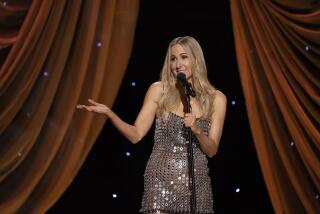Add Parker Posey to the Short List
Where are all the comic actresses? Television is full of successful comediennes, but when it comes to contemporary movies--and especially when it comes to youngish leading ladies whoâve made their mark as comedic sophisticates in the classic sense--you may have to stretch some to even start up a short list. Thereâs Meg Ryan, of course, and then thereâs Meg Ryan, and also, well, er, Meg Ryan.
Hold on, though--the list just got a little longer.
In the independently made romp âParty Girlâ (opening Friday, after a run of the film festivals), Parker Posey finally emerges from the din of Gen-X supporting parts as a one-woman farce to be reckoned with--glamorous and tacky, flamboyant in dress and physical movement, smart around the eyes, extremely droll around the mouth, almost as sweet as she is definitively tart.
As the titular âit girlâ forced to find a life beyond the Manhattan club scene, Posey has the ability to strike the pose, as it were, and hilariously so. But she also gives good vulnerability, even whilst exercising the precious gift of glib. If the movie werenât so small as to possibly get lost, you might consider hers a star-making turn.
âTo me, sheâs really a throwback to Jean Arthur and Barbara Stanwyck and Carole Lombard,â says the movieâs director and co-writer, Daisy Von Scherler Mayer. âIt seems so rare these days that thereâs a heroine out there who is really funny and has a quick wit and sort of a great body and old movie-star glamour.â
Not that Posey is just good for comedy, but, adds her director, âwhy canât Parker have the killer Tom Hanks career--start out as a goofball and then be writing her own ticket? Sheâs so special, sheâs definitely going to be creating her own category. I can just see it going out on [casting] breakdowns--âa Parker Posey type.â â
Parker Posey is Party Girl, say the ads.
Not so, says the actress--though she and her character, Mary, share enough stylistic flamboyance that the surface lines do get a little blurry sometimes.
âMaryâs sort of a bit that I do, that I can break into, like, âOh, you look fabâ--that kind of clubby talk,â says Posey, 26, no stranger to the New York dance scene herself. âWatching it, I think the thing that really stands out as different from me is the movement that she has: the walk, and all those big, fake-surprised looks, all those camped-out gestures that are so cliche from old movies. Itâs a very stylized kind of humor thatâs hard to do, and I think we get away with it by having a â40s kind of slant on it. Screwball/cornball, I like to call it.â
In person, Poseyâs sense of movement is different, but not necessarily toned down. If anything, the movies may not be quite big enough to capture all her campier-than-life charisma.
In two separate interviews, sheâs hard-pressed to ever actually sit down . In our first session, illicitly chain-smoking in a no-tobacco building at the Sundance Film Festival, sheâs squat on the floor, next to a fireplace that conveniently acts as an ashtray. Next session, a few months later in a film execâs office, she deposits herself in a plush chair, but on her knees.
She canât help it. âIâm not comfortable in chairs. People think thatâs an act. But itâs not. I sit kind of where I want, because I guess Iâm more of a physical person; I like to get things from a movement or a gesture.
âIâm one of those hams, sometimes too much. Iâm totally hard to get. Sometimes people donât think Iâm for real. Iâve had casting directors call my managers and ask if I was OK, because I was acting a little strange. Itâs just something I canât help, just like wanting to make people laugh and wanting people to have a good day.â
The part of her that performs in everyday life is not just a âfacade,â but really her, to a large degree. But she admits that, when watching herself on screen, âI find myself threatening to myself. I look at that person on screen and I go, â Looney tune . She is out of control .â â
Posey is a well-read âtoon, at least. Her father was a Mississippi car dealer who did his own commercials, which accounts for some of the hamminess. But heâs also an enthusiast of the English language who read her âJulius Caesarâ in bed as a child and had her diagraming sentences in elementary school.
Though she never developed a Southern accent to speak of at home, she had to work one up for her first major acting gig, as a regular on the CBS soap opera âDays of Our Lives,â a part she landed while still a senior studying drama at SUNY Purchase in New York. There, she played a teen named Tess--âjust a manipulative, âAll About Eve,â flirty with guys, lyingâ you-know-what.
From the soap she segued into a key role in Richard Linklaterâs âDazed and Confused,â as Darla, the high school senior devoted to terrorizing her underclasswomen. Then, her pretty, sharp features and smart mouth may have looked likely to point her toward the kind of career enjoyed by most American movie actresses who inherently project a certain intelligence: perpetual bitch.
Not that there isnât a place for that. âI thought Demi Moore was a riot in âDisclosure,â â Posey says. âI laughed. But thatâs a real problem, I think, in the movies that have been coming out in the last 10 years, that itâs entertaining for writers to think that women have to be bitches or use their sexual power over men to get what they want, without showing another dimension of the character. In real life, strong women are very vulnerable. Why else would they be strong?â
She feels an affinity between âParty Girlâ and âMurielâs Wedding,â at least, and not just in their strong central characters, but their comedically stylized approach to emotional material.
âWhat I think they have in common is, theyâre movies that are glad to be movies. There are a lot of movies now that are just, âWe talk so much, rrr rrr rrr rrr .â That movieâs not really glad to be a movie, it wants to be so real. But âMurielâs Weddingâ and âParty Girl,â theyâll give you the pumps , theyâll give you the clothes , theyâll give you the music . . . â
And the female role modeling, too? Posey saw âParty Girlâsâ arc as offering up a positive example for misfit young women. Well, sort of, considering all the drinking and bad behavior on view.
For all its comedic calories, itâs very much a message movie, one in which the life of the rave--in giving up a certain frantic hedonism for a job as a librarian--finds that high-mindedness is even better than high style. Certainly it has to be the first film in history whose epiphany comes when the main character gets rip-roaring drunk and devotes the night to learning the Dewey decimal system.
âSheâs gotten away by being a socialite, but she hasnât gotten away with being smart,â Posey says of her character. âAnd I think thatâs kind of scary for her, a deep-down part of her, and for a lot of women who feel like they can get by on how they look or dress, and not on believing that they can carry a conversation.â
By movieâs end, the party girl has found both love and literacy, but--lest the preachiness preclude all traces of the former life--is seen still boogying in the final frames. âSheâs someone who is ultimately embracing both sides of herself,â says Posey. âWhich we donât usually see in a comedy.â Or an actress.
More to Read
Only good movies
Get the Indie Focus newsletter, Mark Olsen's weekly guide to the world of cinema.
You may occasionally receive promotional content from the Los Angeles Times.










